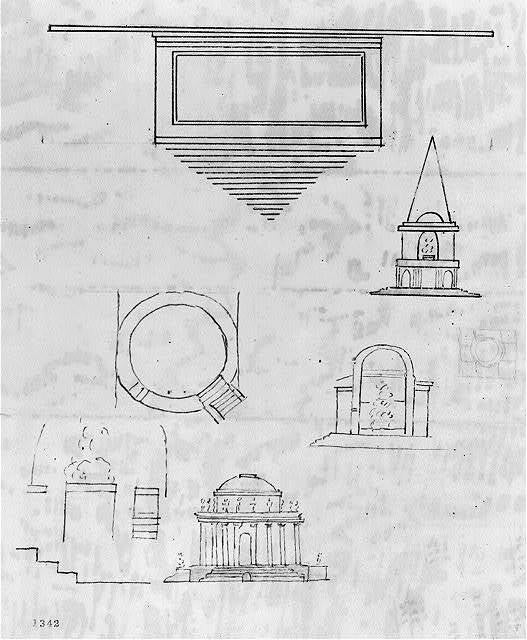From the Capitol to the Patent Office: The Life & Times of Dr. William Thornton

William Thornton: He was born May 20, 1759, at Tortola, British West Indies; served a medical apprenticeship 1777-1781; attended medical school at the University of Edinburgh, 1781-1784; and received his M.D. degree from Aberdeen University in 1784.
He moved to the United States in 1787 and became a citizen in 1788. Encouraged by Benjamin Franklin, Thornton won the competition to design the Philadelphia Library in 1789. Living in Philadelphia he married Anna Maria Brodeau in 1790, and then returned to Tortola (1790-1792) to live on his plantation there. Writing from Tortola, he submitted the winning design for the U. S. Capitol and returned for a lifetime of involvement in the new Federal City.
He was appointed by President Washington to be a Commissioner of the District of Columbia (1794-1802). He was the founder of the U.S. Patent office, and was its Director from 1802 until 1828. On March 28, 1828 he died.
Is that all there was? Not really, and to remember him is to celebrate his times, and to cherish our own. Let's start from the beginning, shall we?
In the spring of 1792, the government of President George Washington had begun requesting designs for the future United States Capitol. The intention was to create a structure that would embody the lofty ideals of the new nation and serve as a defining landmark in a new federal city that was to rise on the banks of the Potomac River.
President Washington envisioned a city that would play a fundamental role in the survival of the Union, with the Capitol building serving as the city's political anchor—a physical counterpart to the Constitution and a kind of temple to the secular religion of republican government.
The design competition for the Capitol, however, presented a host of problems. Then a late entry arrived, by a Dr. William Thornton. The cordial Thornton—"full of hope, and of a cheerful temper," as his wife, Anna Maria, described him—was a nonconformist by temperament, a man who favored lace-trimmed garments that belied his austere Quaker origins. However, Thornton had no formal training in architecture; he took his inspiration largely from examples in books and real life. Despite this, Thornton's design won the contest and he became the First Architect of the Capitol.
Thornton's story, hidden history that has remained long forgotten, is the story of an amateur architect who would go on to design one of the most recognizable buildings in American history & a young nation intent on establishing a capital city worthy of a constitutional republic.
For the rest of William's story, please check out the audio link provided for EPISODE NINE of our podcast, Hidden History:
LISTEN NOW: From the Capitol to the Patent Office: The Life & Times of Dr. William Thornton -
Tune In With Your Favorite Platform!
Images and Documents

Dr. William Thornton.

Anna Maria Thornton, wife of William.

Architectural drawing showing Thornton's proposed design,
known as the Tortola Scheme, 1793.
Library of Congress

Sketches by Thornton show studies for circular, rectilinear, domed, & pyramidal monuments, also notations & computations on verso.
Some schemes probably for Capitol, drawn between 1793 and 1800.
Library of Congress

United States Capitol, Washington, D.C., Floor Plan.
Library of Congress

United States Capitol, Washington, D.C., North (Senate) Wing Elevation, between 1793 and 1800.
Library of Congress

United States Capitol, Washington, D.C., West Elevation High Dome, between 1793 and 1800.
Library of Congress

White House, Washington, D.C.
Sketch - President's House, Executive Offices, South Elevation, between 1793 and 1805.
Library of Congress

Exterior of the Octagon House, Washington, D.C. [between 1909 and 1932]

Interior of Octagon House, Washington, D.C., with oval table upon which the Treaty of Ghent was signed in center of room, c. 1913.

The Octagon House, Washington, D.C.

Tudor Place design.

Tudor Place, Perspective Sketch.
Library of Congress

Tudor Place Floor Plan.


Tudor Place, one of the homes Thornton designed, Washington, D.C.

Anna Maria Brodeau Thornton (Mrs. William Thornton),
1804 by Gilbert Stuart.
National Gallery of Art, Washington, D. C., Online Collection

Blodget's Hotel, built 1793.
Print shows view from street of Blodget's Hotel with stagecoach parked in front, later (from 1802 to 1836) the U.S. Patent Office.
Library of Congress

British Burn the Capitol, 1814, Allyn Cox, 1974.
Corridor, House Wing, First Floor, U.S. Capitol

Ruins of the Thornton family's sugar factory in
British Virgin Islands still stands.

Waterfront fire, probably burning of the Washington Navy Yard, 1814, Anacostia River, Washington, D.C., c. 1815.
Library of Congress

From George Washington to William Thornton, 7 October 1797.

Thomas Jefferson to William Thornton, October 11, 1809,
thanking Thornton for sheep.

Thornton's signature in a letter to President James Madison,
August 12, 1811.

Final resting place of Dr. William Thornton.

The graves of William and his wife Anna.
Resources
- Frary, I. T. They Built the Capitol. (Freeport, N.Y.: Books for Libraries Press, 1969.)
- Stearns, Elinor and David N. Yerkes. William Thornton: A Renaissance Man in the Federal City. (American Institute of Architects Foundation, 1976.)
- Paulson, George W. William Thornton , M.D. - Gentleman of the Enlightenment. (Ohio State University, 2007.)
- https://founders.archives.gov/
- https://www.mountvernon.org/george-washington/death/death-defied-dr-thorntons-radical-idea-of-bringing-george-washington-back-to-life/
- https://www.uspto.gov/about-us/william-thornton





Add comment
Comments
Man talk about the AMERICAN DREAM! This guy came to this country as a doctor and died as an infamous architect. Amazing! 🇺🇸👏🏼
I learned so much!